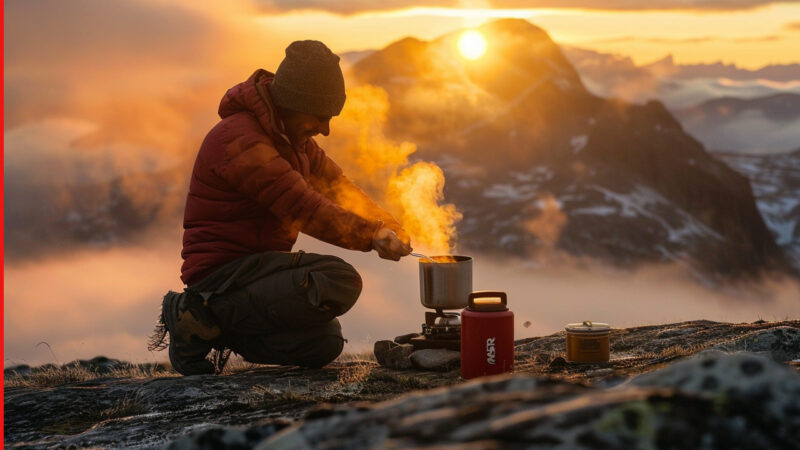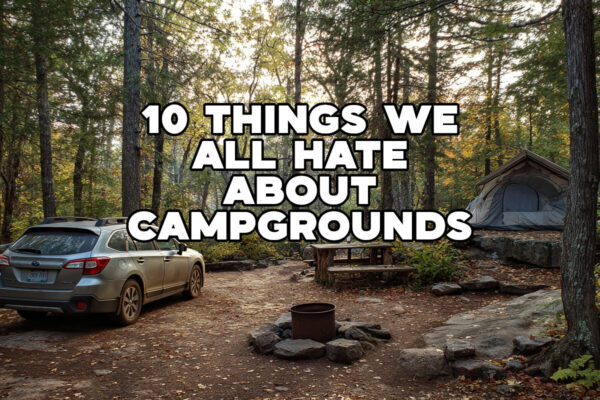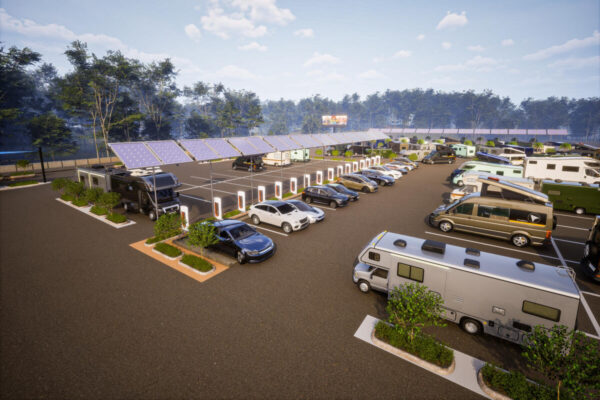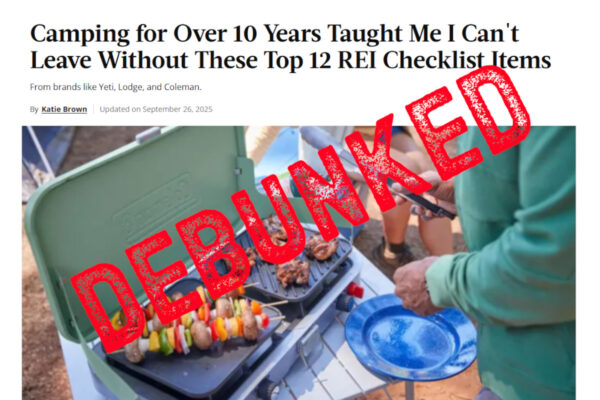Exploring the Different Camp Stove Fuel Varieties
When it comes to fueling your camp stove, you’ve got quite a few choices. Each kind, from propane and canister fuels to liquid ones and even wood-burning options, brings something special to the table. Which one you choose will depend on the type of camping you are doing.
Here is a list of the common camping stove fuels:
1. Propane: The Go-To Choice for Many Campers
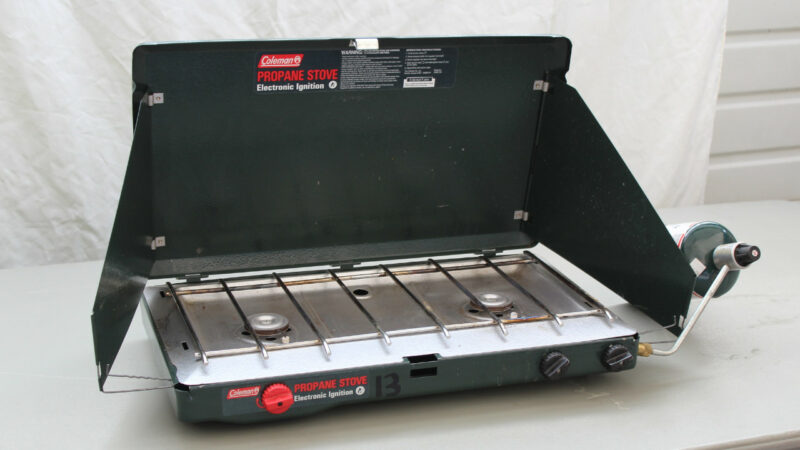
Propane has been a go-to camp stove for years. We have all seen the classic Coleman stoves with the green one-pound canister sitting to the side and I can’t count how many of those I’ve gone through over the years. Here is what you need to know about them.
Propane: The Convenience King
Propane, a liquefied petroleum gas known for its clean burning and reliable performance, reigns supreme as the most user-friendly camp stove fuel. It’s a favorite among many campers for its simplicity. These handy fuel sources come in disposable screw-on canisters, with the two most popular sizes for camping being:
- 1-pound canisters: Perfect for shorter trips or car camping, these lightweight canisters are easy to find and store.
- 5-pound tanks: Ideal for longer camping adventures or groups, these larger canisters provide more cooking time before needing a refill.
No matter the size, using propane is a breeze. Just screw on the canister, flick the igniter, and enjoy the convenience of clean camp stove fuel.
Safety concerns
Propane is a relatively safe cooking fuel when used outdoors and with proper ventilation. The biggest safety concern with propane comes from leaks in enclosed spaces. Propane builds up and can explode if a spark ignites it. That’s why propane has a distinctive odor added – it’s a safety measure to alert you to any leaks.
The easy way to avoid this is to not store your propane in your car, garage, basement, or the like.
Propane: Weighing the Pros and Cons
So, is propane the perfect fuel for your next camp cooking adventure? Let’s take a look at the good, the bad, and the smelly (in a good way!) to help you decide.
Pros:
- Simple to Use: Screw on the canister, flick the igniter – that’s it!
- Clean Burning: Propane leaves minimal soot on your camp stove.
- Cold Weather Warrior: Propane performs well in cold temperatures.
- Wide Availability: Propane canisters are easy to find at most camping stores and retailers.
- Long-lasting Option: While not backpack-friendly due to weight, 5-pound propane tanks offer extended cook times ideal for car camping or basecamp setups.
- Versatile: Propane can also be used to power camp heaters and lanterns.
Cons:
- Heavy Hauler: Propane canisters can be heavier than some other fuel options.
- Disposable Dilemma: One pound canisters are disposable, which can be less eco-friendly and add to costs on long trips.
- Not Refillable: Once the fuel in one pound tanks are used, you aren’t supposed to refill the canister. (But lots of people do)
Check out my post on the 5
best refillable small propane tanks for camping!
Propane – The Cold Weather King
While some fuels fizzle out in frigid weather, propane thrives! This champion of cold performs well even at temperatures down to around zero degrees Fahrenheit. Here’s the science behind its success: propane has a relatively low boiling point of -44°F (-42°C). This means it easily transforms from a liquid to a gas even in chilly conditions, allowing it to vaporize and burn effectively. So, you can enjoy hot meals on shoulder-season adventures or conquer mountaintops without sacrificing cooking efficiency.
However, it’s important to note that propane isn’t entirely invincible in the cold. The biggest hurdle you might face in extreme cold (well below zero) is the potential for the regulator to freeze. The regulator is the part of your camp stove that controls the flow of gas from the canister. If it freezes, it can restrict or completely stop propane from reaching the burner, hindering your ability to cook.
The takeaway? Propane reigns supreme for cold-weather camping in most situations. But if you’re venturing into truly frigid territory, be aware of the potential for regulator freezing and take appropriate precautions (like using insulated covers or storing canisters in a warmer place).
Propane: Perfect for Convenient Camp Cooking
For campers who prioritize convenience and ease of use, propane shines! Here’s why it might be the perfect match for your next non-backpacking adventure:
- Car Campers: Setting up camp after a long drive? Propane wins for simplicity. Attach the canister, light it up, and enjoy cooking without any messy priming.
- Fair-Weather Enthusiasts: Heading out for a weekend getaway and planning on car-camping style meals? Propane’s user-friendliness makes meal prep a breeze.
- Shoulder Season Adventurers: Conquering cooler temperatures? Propane tackles the challenge. It performs well even when the weather turns chilly, ensuring you can still cook hot meals during spring, fall, or high-altitude escapades.
- Group Getaways: Cooking for a crowd? Larger propane canisters or even 5-pound tanks offer extended cook times, keeping everyone at your campsite happily fed.
Propane camping stoves
Now that we have talked about propane as a fuel, here are some propane camping stoves to consider for your next outing:
2. Canister fuels for backcountry cooking
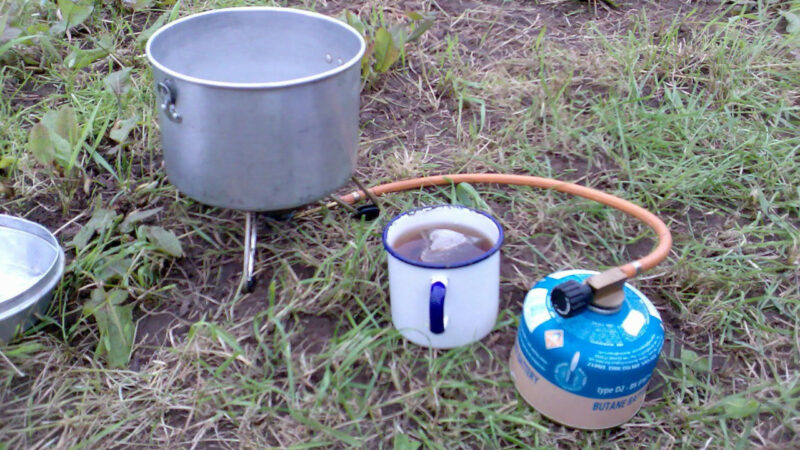
Next up, let’s talk about canister fuel. These little canisters are popular with backpackers for a reason. They’re lightweight, easy to use, and pack down small. But are they right for every camping trip? Let’s dig in and see what the pros and cons are!
Canister fuel, also known as isobutane fuel, reigns supreme for backpackers seeking a lightweight and convenient cooking solution. These compact, pre-filled canisters screw onto specialized camp stoves, providing a clean-burning fuel source for your backcountry meals. No messy priming or refilling required – just screw on the canister, light it up, and enjoy the ease of camp cooking on the trail. But are canister fuels a perfect fit for every adventure? Let’s explore the different fuel mixes available and weigh the pros and cons to see if they’re the right match for your next backpacking trip!
Canister Fuel Types
Canister fuels come in various blends, each with its own strengths and weaknesses. The two main components are isobutane and propane, with some canisters including n-butane as well. Here’s a breakdown of how these components affect performance:
- Isobutane: The champion of cold weather performance, isobutane canisters maintain good pressure even in chilly conditions. However, they may have a slightly lower overall heat output compared to some other canister fuel mixes.
- Propane: Known for its high heat output, propane performs well in most conditions. However, propane canisters struggle in very cold weather because propane has a higher boiling point and can struggle to vaporize.
- n-Butane: This gas offers a lower heat output and limited cold-weather performance compared to isobutane and propane. However, it’s sometimes included in canister fuel mixes because it’s a cheaper alternative.
Choosing the Right Blend:
Manufacturers often create canister fuel blends targeted for specific seasons or conditions. Here’s a breakdown of some common types:
- 3-Season Mix (Isobutane/Propane Blend): A popular choice, this blend offers a good balance between cold-weather performance (thanks to the isobutane) and heat output (thanks to some propane). It’s suitable for most spring, summer, and fall camping trips.
- 4-Season Mix (Higher Isobutane): Prioritizing cold-weather dependability, this blend has a higher concentration of isobutane. This ensures good performance in shoulder seasons or even winter camping (down to around freezing). Keep in mind, the trade-off might be a slightly lower overall heat output compared to a 3-season mix.
- Ultralight Mix (Isobutane/n-Butane Blend): These blends prioritize weight savings by including some n-butane, a lighter gas. However, this comes at the cost of reduced heat output and worse cold-weather performance. These canisters might be a good option for weight-conscious backpackers on short trips in warm weather, but they’re not ideal for colder conditions.
By understanding the different components and blends, you can choose the canister fuel that best suits your backpacking adventures!
Are Canister Fuels Safe?
Canister fuels are very safe when used correctly. Just remember to store them away from heat sources, including direct sunlight, and no puncturing these guys until they are spent and ready for disposal.
Pros and Cons Of Canister Fuels
Canister fuel reigns supreme for backpackers due to its lightweight and user-friendly nature. These compact, pre-filled canisters screw onto specialized camp stoves, offering a clean-burning fuel source for backcountry meals. But are canister fuels the perfect fit for every adventure? Let’s weigh the pros and cons to see if they’re the right match for your next backpacking trip!
Pros:
- Lightweight Champion: Canister fuels wins the weight battle. These compact canisters are much lighter than liquid fuel options, making them ideal for weight-conscious backpackers.
- Simplicity Reigns Supreme: No messy priming or refilling required. Just screw on the canister, light it up, and enjoy hassle-free camp cooking.
- Cold Weather Performance (with limits): Isobutane-based canisters perform well in chilly conditions, making them suitable for shoulder-season camping or even some winter adventures (depending on the blend).
- Clean Burning: Canister fuels leave minimal soot on your camp stove, keeping cleanup easy.
- Wide Availability: You’ll find canister fuels at most camping stores and outdoor retailers, making resupply on trails convenient.
Cons:
- The Price of Convenience: Canister fuel can be more expensive per BTU (British thermal unit) compared to other fuel options like liquid fuel. Since canisters are disposable, the cost can add up over longer trips.
- Not Refillable: Once the fuel in a canister is used, you can’t refill it. This can be a drawback for long thru-hikes or for budget-minded backpackers.
- Cold Weather Limitations (with extreme cold): While they perform well in chilly weather, canister fuels, particularly those with high propane content, can struggle in extremely cold temperatures due to issues with vaporization.
- Disposal Considerations: Empty canisters require proper disposal, which can be challenging in remote areas. Look for recycling options or follow local regulations.
The Takeaway:
Canister fuel offers unbeatable convenience and ease of use for backpackers. They’re lightweight, require minimal setup, and perform well in most weather conditions. However, the cost, disposability, and limitations in extreme cold are factors to consider. Weigh the pros and cons against your backpacking style and priorities to see if canister fuel is the perfect match for your next adventure!
Common canister stoves
Now that you’ve explored the world of canister fuels, let’s delve into the stoves themselves! Canister stoves are specifically designed to work with the pre-filled fuel canisters we discussed previously. These lightweight and user-friendly camp kitchens are a favorite among backpackers for their convenience and efficiency.
3. White Gas: The Versatile and Powerful Option
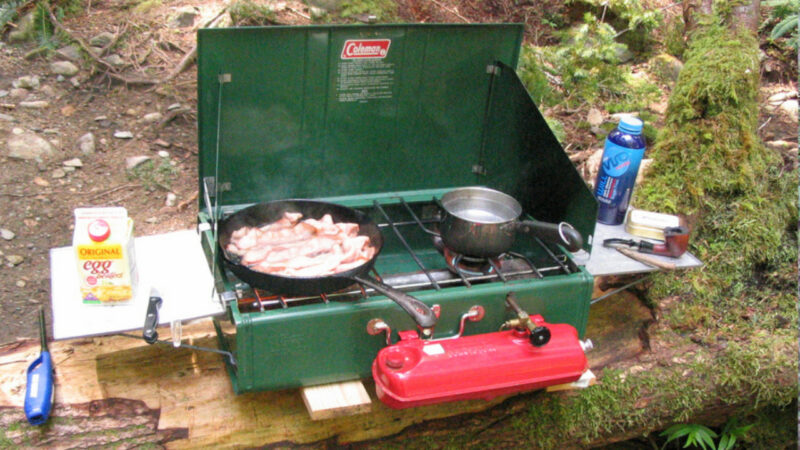
White gas stoves, also known as naptha stoves, are a favorite among backpackers and campers who prioritize power and versatility in their backcountry cooking. This is the stove I remember from my youth when we went camping.
These stoves burn hot and clean, making them ideal for boiling water quickly or searing food in the outdoors. But don’t be fooled by the power – these stoves can also simmer beautifully, allowing you to whip up delicate meals on your next adventure. Unlike disposable canisters, white gas stoves are refillable, saving you money on long trips.
This refillable nature, along with their ability to perform well in various weather conditions, makes them a compelling choice for experienced backpackers and adventurers who value performance and value.
Safety concerns with white gas
White gas stoves offer impressive power and versatility, but with that power comes a responsibility to handle them safely. Here’s a breakdown of the key safety concerns to keep in mind:
- Flammability: White gas is a flammable liquid. Spills can ignite easily, so proper handling and storage are crucial.
- Pressurized System: Some white gas stoves use pressurized fuel canisters. These canisters can rupture if not handled properly. Follow the manufacturer’s instructions for safe use and storage.
- Priming: The priming process, used to preheat the stove before lighting, involves flammable liquid. Be mindful of open flames or sparks during priming.
- Maintenance: Regular maintenance is essential for safe operation. Leaking fuel lines or malfunctioning components can pose a fire hazard. Inspect your stove regularly and follow recommended maintenance procedures.
- By understanding these safety considerations and practicing proper handling techniques, you can enjoy the benefits of white gas stoves while minimizing risks on your camping adventures.
Pros and Cons of White Gas
White gas stoves offer a compelling alternative to canister stoves, but they come with their own set of pros and cons. Let’s weigh them out to see if they’re the right fit for your next backpacking trip!
Pros:
- Powerful Performance: White gas stoves deliver serious heat output, making them ideal for boiling water quickly in cold weather or searing food.
- Simmering Savvy: Despite the power, these stoves can also simmer effectively, allowing for more diverse backcountry cooking.
- Fuel Efficiency and Cost Savings: Refillable white gas canisters offer significant cost savings compared to buying disposable canisters, especially on longer trips.
- All-Weather Reliability: White gas performs well in various conditions, making it a dependable choice for year-round camping.
- Multi-Fuel Options: Some white gas stoves can also burn other fuels like kerosene or unleaded gasoline, offering additional flexibility on remote trips (with proper maintenance considerations).
Cons:
- Steeper Learning Curve: Operating and maintaining white gas stoves requires more practice compared to canister stoves. Priming, pumping, and proper maintenance procedures add complexity.
- Safety Concerns: White gas is flammable and requires careful handling to avoid spills and fires. Fumes from burning white gas necessitate proper ventilation.
- Messier Operation: White gas stoves can be messier to use than canister stoves. Spills are more likely during priming and refilling, requiring proper cleaning procedures.
- Bulkier and Heavier: White gas stove systems typically weigh more than canister stove systems due to the fuel canister and pump.
- Fuel Availability: White gas may not be readily available at all outdoor stores, unlike canister fuel.
When White Gas Reigns Supreme
White gas stoves truly come into their own in several key scenarios:
- Conquering Cold and High Altitudes: Canister fuel struggles in frigid temperatures and thin air. White gas, on the other hand, maintains impressive performance, making it a reliable heat source for winter camping or high-altitude expeditions.
- Long Expeditions and Remote Locations: The refillable nature of white gas stoves makes them a budget-friendly option for extended trips. Plus, the ability to burn multiple fuels (with proper maintenance) offers adaptability in situations where finding your usual fuel source might be difficult.
- Backcountry Chefs: Despite their powerful heat output, white gas stoves can also simmer beautifully. This versatility allows you to tackle a wider range of backcountry recipes, from quick boils to slow-cooked stews.
- Value-Conscious Backpackers: For backpackers who prioritize cost-efficiency, especially on longer trips, the refillable nature of white gas stoves translates to significant savings compared to buying disposable canisters.
If you find yourself in any of these situations, a white gas stove might be the perfect companion for your next adventure!
Unleaded Gasoline: Friend or Foe?
White gas is the recommended fuel for white gas stoves, but some backpackers are tempted by unleaded gasoline due to its wider availability and lower cost at gas stations. While it may seem like a quick substitute, there are important considerations before you douse your stove in unleaded fuel.
On the plus side, unleaded gasoline is readily available at most gas stations, unlike white gas which can be harder to find, especially in remote areas. The price tag is also typically lower, making it an attractive option for budget-conscious backpackers.
However, the convenience of unleaded gasoline comes with a cost. Unlike white gas, unleaded gasoline burns less cleanly. This can lead to a buildup of soot in your stove’s jets, causing performance problems and requiring more frequent maintenance. Additionally, using unleaded gasoline may void the warranty on your white gas stove, as manufacturers typically specify white gas as the approved fuel.
It’s crucial to consult your stove’s manual for specific fuel recommendations – not all white gas stoves are compatible with unleaded gasoline. Using an incompatible fuel can damage your stove and lead to safety hazards.
In the end, while unleaded gasoline may seem like a cheaper and easier option, the potential downsides can outweigh the benefits.
Top White Gas Stoves For Camping
4. Alcohol Fuels: A Simple but Limited Solution
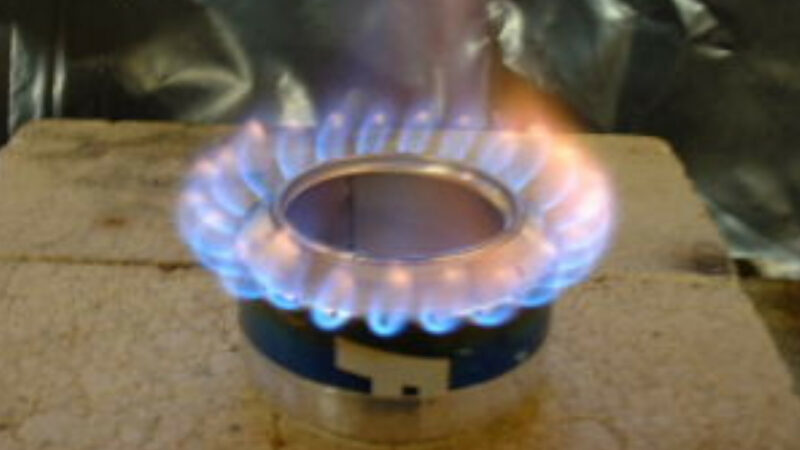
In the days of yore, for backpackers and campers venturing into the wilderness, alcohol fuel reigned supreme. I know I have one in my pile that I made from two Pepsi cans.
Fueled by readily available methanol or denatured ethanol, these stoves were beloved for their sheer simplicity. A quick stop at the local hardware store could equip you with enough fuel to last a lifetime of camp meals.
However, the winds of change are blowing in the world of camp stove fuels. While the eco-friendly nature and ease of use of alcohol stoves remain undeniable draws, advancements in other fuel options have highlighted some limitations of alcohol.
As a result, some campers are exploring alternatives. Let’s embark on a journey into the world of alcohol fuel, examining both its enduring appeal and the factors contributing to its decline in popularity.
The Fire Hazards With Alcohol Stoves
While alcohol fuel is easy to use, remember – it’s flammable!
Open flames on alcohol stoves pose a risk in windy conditions or fire-restricted areas. Spills can happen during refilling or if you knock over your stove, creating a fire hazard.
You have to be extra cautious because burning alcohol flames can be hard to see in daylight, making it easy to set fire to things and not notice until it is too late.
Advantages and Disadvantages Lists
Alcohol fuel offers a compelling combination of simplicity and eco-friendliness, making it a popular choice for many backpackers and campers. However, like any fuel source, it comes with its own set of advantages and disadvantages.
Pros:
- Simple and User-Friendly: Alcohol stoves are known for their straightforward design. No priming, pumping, or pressurized canisters are involved, making them a user-friendly option for beginners and experienced campers alike.
- Lightweight and Portable: Alcohol fuel itself is lightweight, adding minimal weight to your backpack. It’s also readily available at many stores, eliminating the need for specialized canisters.
- Clean Burning: Alcohol fuels burn cleanly, emitting minimal smoke and leaving little soot residue on your camp stove. This is a major plus for environmentally conscious campers and those who appreciate a less messy cooking experience.
- Affordable: Alcohol fuel itself is often a more affordable fuel choice compared to canister or white gas options. The stoves themselves tend to be on the less expensive side as well.
Cons:
- Lower Heat Output: While convenient, alcohol fuel burns with a lower heat output compared to other camping stove fuels. This translates to longer boil times for water and can make simmering food a challenge.
- Cold-Weather Performance: Alcohol struggles in frigid temperatures. As the temperature drops, the fuel gels and becomes difficult to ignite, hindering its effectiveness in winter camping scenarios.
- Open Flame Concerns: Many alcohol stoves utilize an open flame design, raising safety concerns. This can be a risk in areas with fire restrictions or during windy conditions. Additionally, burning alcohol flames can be difficult to see in daylight, increasing the risk of burns.
- Limited Fuel Efficiency: Alcohol doesn’t pack the same energy density as other fuels. You may need to carry more fuel for longer trips compared to using canister or white gas stoves.
Alcohol Fuel Stoves Are Slow
One of the biggest trade-offs when using alcohol fuel is its lower energy output compared to other camping stove options. While it might seem like a minor detail, this characteristic can significantly impact your camp cooking experience.
The most noticeable consequence is the slower boil times. That morning cup of coffee or rehydrating a backpacking meal takes noticeably longer with an alcohol stove. This can be a real test of patience, especially when hunger sets in or mornings are chilly.
I can tell you from personal experience, that compared to other fuels, alcohol is maddeningly slow to boil water
Who alcohol fueled stoves are best for
Despite some drawbacks, alcohol stoves remain a solid option for specific campers. Simplicity seekers rejoice – their no-frills design requires minimal setup and fuss, perfect for beginners or those who prioritize getting on with enjoying the outdoors. Eco-conscious backpackers will appreciate the clean burn of alcohol fuel, leaving a smaller footprint on their campsites.
Weight-conscious backpackers, particularly ultralighters, won’t be burdened by the feathery-light fuel canisters. Solo adventurers with basic meals will find alcohol stoves perfectly adequate for quick and easy camp cooking. For those who don’t require elaborate backcountry cuisine, the limitations of alcohol fuel are easily outweighed by its convenience and ease of use.
Alcohol Stoves
While some people simply make their own alcohol fueled stoves from old pop or beer cans, there are several purpose built alcohol stoves on the market:
- Kuvik’s Titanium Alcohol Stove
- Boundless Voyage Camping Titanium Spirit Alcohol Stove
- Titanium Portable Backpacking Stove
5. Wood-Fired Stoves: A Classic Reimagined
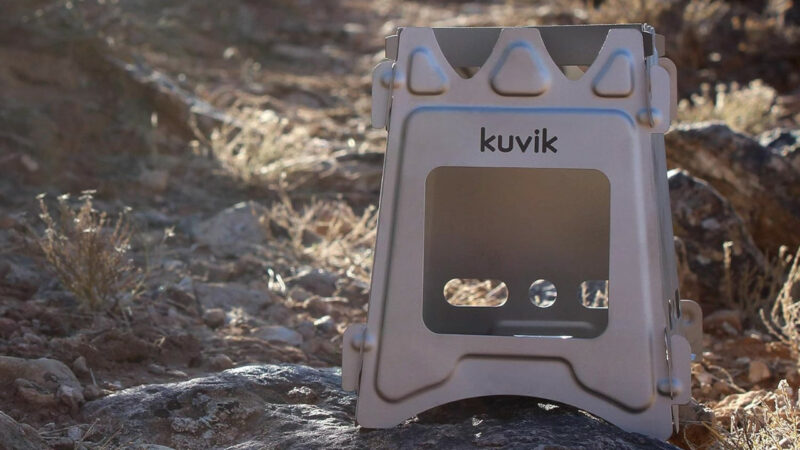
For backpackers and campers seeking a rustic and fuel-independent cooking experience, wood-fired camp stoves have long held a special charm. These traditional stoves rely on readily available twigs and branches for fuel, making them a convenient option in forested environments. However, traditional wood stoves often suffered from bulk and inefficiency.
The modern era has witnessed a revolution in wood-fired stoves. Innovative materials like titanium have made them lighter and more portable, perfect for weight-conscious backpackers. These new titanium stoves boast impressive durability while minimizing the burden on your back.
Companies like BioLite have taken the concept even further, introducing wood-fired stoves with advanced features like integrated fans and electricity generation capabilities.
These high-tech options combine the traditional appeal of wood fuel with modern conveniences like faster boil times and even the ability to charge your devices.
What these are best for
For campers who love the classic and natural way of camping, wood stoves are a perfect match. They’re not only good for the environment because wood is something that can grow back and you can find it almost everywhere, but they also make cooking outdoors simple and enjoyable.
With these stoves, all you need to do is collect some wood and you’re ready to start a fire and cook your food. exbit fuThey’re especially handy when you’re in places with lots of trees where picking up fallen branches for fuel won’t be an issue.
But remember, whenever using them, it’s important to stick to what local rules say about gathering and burning wood so we don’t harm nature while enjoying our camping adventures.
Safety concerns
The flickering flames of a wood stove might be inviting, but remember – safety is paramount. Here’s a quick rundown of key safety considerations:
- Open Flame Hazards: Wood stoves, unlike some canister stoves, use open flames. This poses a risk in windy conditions or fire-restricted areas. Always check local fire restrictions before using a wood stove, and be prepared to extinguish it if necessary.
- Beware of Sparks: Even if the risk is low and your fire small, flying embers from the stove can still potentially ignite dry leaves or brush, starting a dangerous wildfire. Clear a safe zone around the stove and keep a bucket of water or fire extinguisher nearby for emergencies.
Advantages and Disadvantages Lists
Wood-fired camp stoves offer a unique blend of rustic charm and practicality for backpackers and campers. However, like any fuel source, they come with both advantages and disadvantages. Let’s weigh the pros and cons to help you decide if a wood-fired stove is the right fit for your next adventure.
Pros:
- Fuel Availability: Wood is a readily available fuel source in forested environments, eliminating the need to carry additional fuel canisters. This can be a major advantage for extended backpacking trips.
- Renewable and Eco-Friendly: Burning wood is considered a renewable resource, especially if using responsibly sourced deadwood. This eco-friendly aspect appeals to environmentally conscious campers.
- Ambiance and Cooking Versatility: The crackling flames of a wood stove create a cozy and inviting atmosphere at camp.
Cons:
- Open Flame Concerns: Unlike canister stoves, wood stoves utilize open flames, posing a safety risk in windy conditions or fire-restricted areas. Always check local regulations and be prepared to extinguish the fire if needed.
- Weight and Bulk: Traditional wood stoves can be heavy and bulky compared to other camp stove options. However, advancements in materials like titanium have led to lighter and more portable models.
- Finding Fuel: Using a wood stove for cooking means taking the time to find fuel when it is time to set up camp. In some places that is easy, others it might be a challenge.
- Skill and Maintenance: Operating a wood-fired stove requires some practice and knowledge of firecraft skills like starting and maintaining a fire efficiently.
- Weather Dependence: Dry wood can be difficult to find or may be wet in some weather conditions, hindering the effectiveness of the stove.
Compact wood stoves
For those who love camping, compact wood stoves are a go-to because they’re easy to carry around and really handy. With their lightweight design, these stoves make it simple for backpackers and outdoor enthusiasts to take them along on their adventures.
Here are a few of the compact wood stoves for backpackers on the market:
- TOAKS Titanium Backpacking Wood Burning Stove
- BioLite CampStove 2+
- Ultralight Titanium Wood Burning Stove
6. Esbit Solid Fuel Tablets: Lightweight and Emergency Fuel
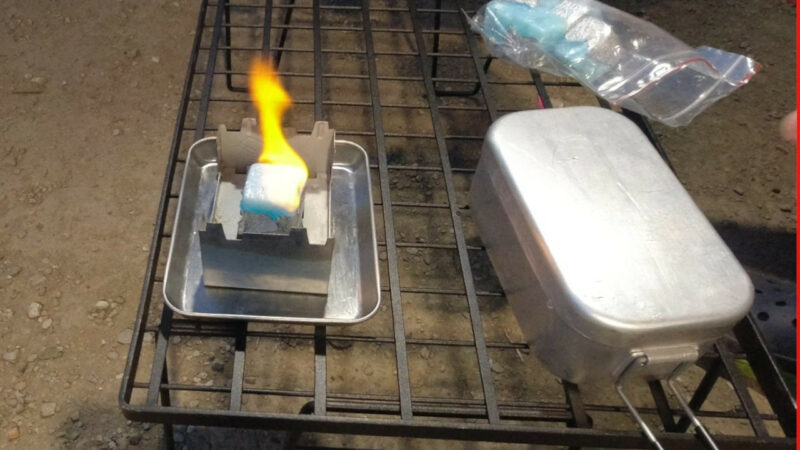
In the realm of camp stove fuels, solid fuel tablets offer a unique combination of convenience and portability. These compact, pre-measured blocks of fuel are a popular choice for backpackers and campers seeking a simple and hassle-free way to cook outdoors.
Esbit fuel tablets are made from various combustible materials, such as hexamine, trioxane, or other solidified alcohol-based compounds. Each type of tablet has its own burn characteristics.
They are an easy way to boil water, heat meals, or even start campfires. Let’s delve into the world of solid fuel tablets, exploring their advantages, limitations, and how they might fit into your next outdoor adventure.
Safety concerns
Solid fuel tablets offer convenience, but safety should always be the top priority when using them for camp cooking. Here’s a breakdown of the key safety concerns to keep in mind:
- Inhalation Risks: Burning solid fuel tablets produces fumes that can be harmful if inhaled, particularly in poorly ventilated spaces like tents. Ensure proper ventilation when using these tablets indoors or in enclosed areas.
- Open Flame and Fire Hazards: While some solid fuel tablets burn with a less prominent flame than wood stoves, they still involve an open flame. This poses a risk in areas with fire restrictions or during windy conditions. Accidental spills or improper handling can also lead to flare-ups.
- Hot Surfaces and Burns: Solid fuel tablets burn hot, and the stove itself can become very hot during use. Accidental contact with the burning fuel or a hot stove can lead to painful burns.
Solid Fuel Tablet Stoves: Weighing the Pros and Cons
Solid fuel tablet stoves offer a compelling blend of convenience and portability, making them a popular choice for backpackers and campers. However, like any fuel source, they come with both advantages and disadvantages. Let’s explore both sides of the coin to help you decide if a solid fuel tablet stove is the right fit for your next outdoor adventure.
Pros:
- Simple and User-Friendly: Solid fuel tablet stoves are known for their straightforward design. No priming, pumping, or pressurized canisters are involved. Just light the tablet and get cooking, making them ideal for beginners and experienced campers alike.
- Lightweight and Compact: Solid fuel tablets themselves are lightweight, adding minimal bulk to your backpack. The stoves themselves are often compact and foldable, making them a space-saving option for packing.
- Clean Burning: Solid fuel tablets typically burn clean, emitting minimal smoke and leaving little soot residue on your camp stove. This is a plus for environmentally conscious campers and those who appreciate a less messy cooking experience.
- Easy Fuel Availability: Solid fuel tablets are widely available at outdoor stores, convenience stores, and even some hardware stores. This eliminates the need to find specialized fuel canisters, making them a convenient option, especially for last-minute camping trips.
Cons:
- Lower Heat Output: Similar to alcohol fuel, solid fuel tablets burn with a lower heat output compared to canister or white gas stoves. This translates to longer boil times for water and can make simmering food a challenge.
- Limited Fuel Efficiency: While lightweight, the compact size of solid fuel tablets means you might need to carry more fuel for longer trips compared to other options. Be sure to factor in the number of tablets needed for your trip to avoid running out.
- Open Flame Concerns: Many solid fuel tablet stoves utilize an open flame design, raising safety concerns in areas with fire restrictions or during windy conditions. Accidental spills or improper handling can also lead to flare-ups.
- Difficult to Extinguish: Unlike canister stoves with adjustable flames, solid fuel tablets burn continuously until they’re spent. This can be inconvenient if you need to extinguish the flame prematurely, requiring you to wait for the tablet to burn out completely or resort to smothering it with a pan or pot (use caution with this method!).
What these are stoves best for
For those who love camping, solid fuel tablets are a great match for specific situations like:
- When you’re getting ready for emergencies: With their long shelf life and easy storage, solid fuel tablets are perfect for emergency kits. They can be a dependable heat source when there’s no power or in other urgent cases.
- For backpackers keeping it light: These tablets are super lightweight and don’t take up much space, making them awesome for backpackers who need to pack light. They’re especially handy if you’re hiking solo or just really need to watch the weight of your gear.
- If you’re camping by yourself: Solid fuel tablets come in handy when you only need to cook or boil water just for one person. Starting them up is simple, and they give off enough heat to meet your cooking needs without any fuss.
While they might not be the best choice if you’re camping with a big group or need to boil water quickly, solid fuel tables shine by offering ease and dependability in certain outdoor adventures.
Esbit Fuel Tablet Stoves
Because they are so uncomplicated, there are a wide variety of fuel tablet stoves on the market. These range from simple fold out stoves, to more fancy ones with a matching pot and stand with wind-shield. Here are some examples:
Choosing the Right Camp Stove Fuel for Your Camping Adventure
A crackling fire might be the heart of a campsite, but for satisfying meals under the stars, your camp stove fuel is the unsung hero. Selecting the right fuel depends on what kind of camping experience you’re after.
For campers who prioritize convenience, canister fuel is a lifesaver. Lightweight and user-friendly, these canisters clip right onto your stove and deliver reliable performance in most weather conditions. No fuss, no muss, just boil water and whip up a camp-cooked masterpiece. However, the ease of use comes at a cost – canister fuel can be pricier than other options, and the disposable canisters generate waste.
If you’re an experienced camper who values power and affordability, white gas might be your perfect fuel. White gas stoves pack a punch, allowing you to boil water quickly and simmer your meals to perfection. Plus, the refillable nature of white gas makes it a cost-effective choice for longer camping trips. Keep in mind though, white gas requires more practice to operate and maintain safely. Mastering the priming and pumping techniques is crucial to avoid any mishaps on your camping adventure.
For campers seeking simplicity and a lighter footprint, alcohol stoves offer a charming alternative. These lightweight stoves burn clean and are ideal for shorter trips or solo adventures with basic culinary needs. However, alcohol stoves have a lower heat output compared to other options, and their reliance on an open flame necessitates extra caution when using them.
Finally, for campers who crave a rustic and self-sufficient experience, wood-fired stoves offer a unique approach. These stoves utilize readily available twigs and branches, making them both budget-friendly and environmentally conscious. However, open flames pose safety risks, and finding dry fuel can be challenging in some environments.

